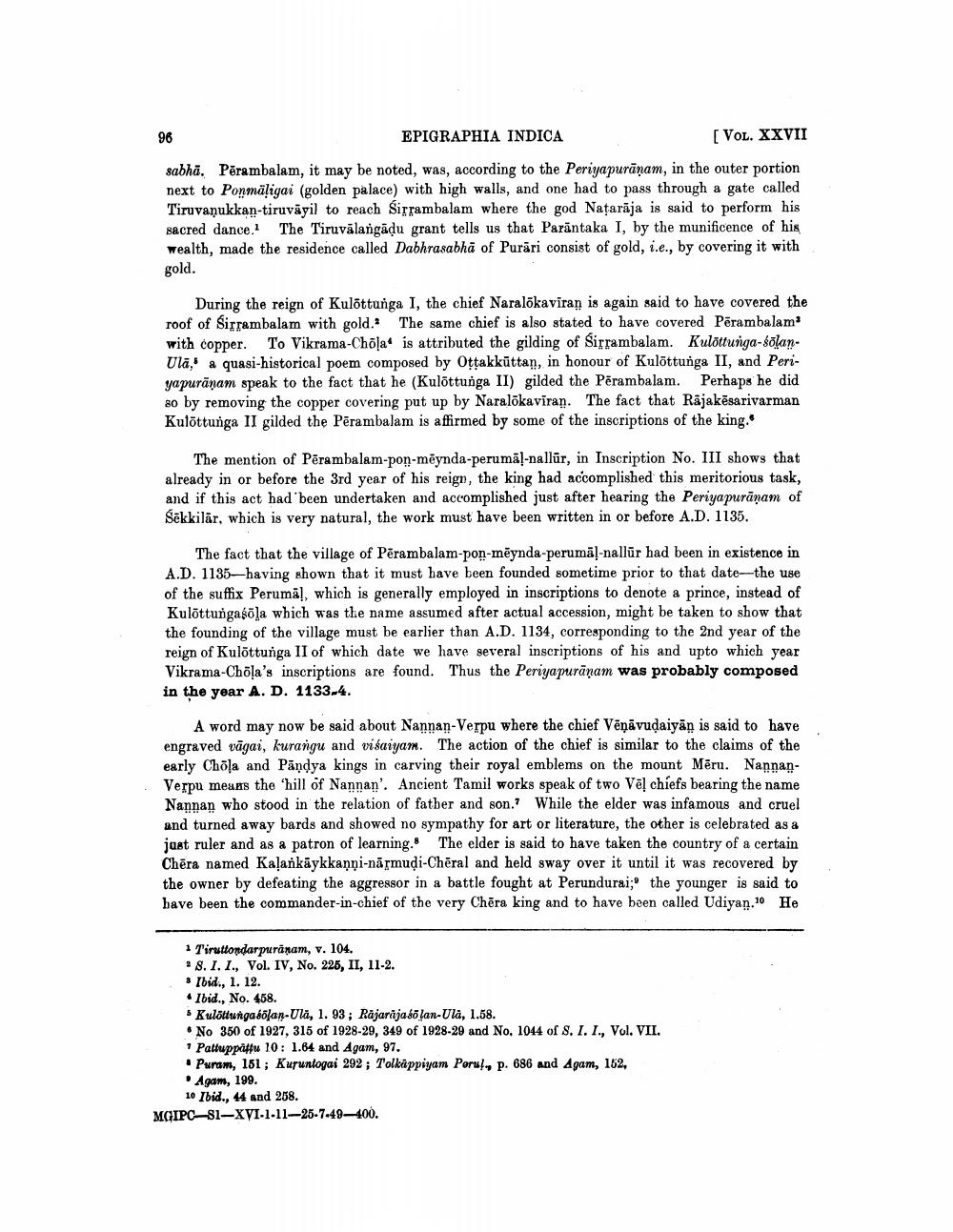________________
96
EPIGRAPHIA INDICA
[VOL. XXVII
sabha. Pērambalam, it may be noted, was, according to the Periyapurānam, in the outer portion next to Ponmäligai (golden palace) with high walls, and one had to pass through a gate called
Tiruvanukkan-tiruväyil to reach Sirrambalam where the god Nataraja is said to perform his sacred dance. The Tiruvälangadu grant tells us that Parantaka I, by the munificence of his wealth, made the residence called Dabhrasabhā of Purări consist of gold, i.e., by covering it with gold.
During the reign of Kulöttunga I, the chief Naralēkavīran is again said to have covered the roof of Sirrambalam with gold. The same chief is also stated to have covered Pērambalam with copper. To Vikrama-Chola is attributed the gilding of Sirrambalam. Kulottunga-bolanUlā,' a quasi-historical poem composed by Ottakkūttan, in honour of Kulöttunga II, and Periyapurānam speak to the fact that he (Kulõttunga II) gilded the Pērambalam. Perhaps he did 80 by removing the copper covering put up by Naralēkavīran. The fact that Rajakësarivarman Kulottunga II gilded the Pērambalam is affirmed by some of the inscriptions of the king.
The mention of Pērambalam-pon-méynda-peruma!-nallür, in Inscription No. III shows that already in or before the 3rd year of his reign, the king had accomplished this meritorious task, and if this act had been undertaken and accomplished just after hearing the Periya puranam of Sēkkilär, which is very natural, the work must have been written in or before A.D. 1135.
The fact that the village of Pērambalam-pon-měynda-perumal-nallür had been in existence in A.D. 1135-having shown that it must have been founded sometime prior to that date--the use of the suffix Perumal, which is generally employed in inscriptions to denote a prince, instead of Kulöttungagola which was the name assumed after actual accession, might be taken to show that the founding of the village must be earlier than A.D. 1134, corresponding to the 2nd year of the reign of Kulöttunga II of which date we have several inscriptions of his and upto which year Vikrama-Chöļa's inscriptions are found. Thus the Periyapuränam was probably composed in the year A. D. 1133-4.
A word may now be said about Nannan-Verpu where the chief Vēņāvudaiyān is said to have engraved vāgai, kurangu and visaiyan. The action of the chief is similar to the claims of the early Chola and Pandya kings in carving their royal emblems on the mount Mēru. NannanVerpu means the hill of Nannan'. Ancient Tamil works speak of two Vēļ chíefs bearing the name Nannan who stood in the relation of father and son. While the elder was infamous and cruel and turned away bards and showed no sympathy for art or literature, the other is celebrated as a jast ruler and as a patron of learning. The elder is said to have taken the country of a certain Chēra named Kaļankäykkanni-nārmudi-Chēral and held sway over it until it was recovered by the owner by defeating the aggressor in a battle fought at Perundurai;o the younger is said to have been the commander-in-chief of the very Chēra king and to have been called Udiyan.10 He
1 Tiruttondarpuränam, v. 104. 28.1. 1., Vol. IV, No. 226, II, 11-2. * Ibid., 1. 12. • Ibid., No. 458.
Kulottungaböjan-Ulā, 1. 93; Rajarajasolan-Ula, 1.58. • No 350 of 1927, 315 of 1928-29, 349 of 1928-29 and No. 1044 of 8. I. I., Vol. VII. * Pattuppaffu 10: 1.84 and Agam, 97. • Puram, 161; Kusuntogai 292 ; Tolkappiyam Porul., p. 686 and Agam, 162,
Agam, 199.
10 Ibid., 44 and 258. MGIPC-S1-XVI.1.11-25-7.49–400.




